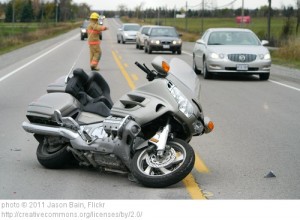Automobile Accident Motorcycle Crash Attorney
Automobile Accident and Motorcycle Crash Attorney

Automobile Accident Attorney
Due to increased risk of injury and the general perceptions of motorcyclists, someone injured in a collision between a motorcycle and another motor vehicle will usually benefit from consulting a personal injury attorney. After a collision with a motorcycle, it is very common for an automobile driver to state that he or she didn’t even see the motorcycle before the collision.
Dangerous driving conduct, whether by motorcyclists or the drivers of other vehicles, contributes to the likelihood of an accident. The public has negative attitudes toward motorcyclists, which is derived from the driving conduct of a small number of motorcyclists, general misperceptions, and even the influence of stereotypes from movies and television. These attitudes in turn affect how motorcyclists are treated by other drivers while sharing the road. They can also can lead people to pre-judge or assume that a motorcyclist is somehow at fault in an accident, even if the only negligent conduct was on the part of the other driver.
Here are six (6) causes derived from driver conduct that contribute to vehicle accidents:
1. Lane Changes: Drivers may fail to notice a motorcyclist in a blind spot, or may otherwise fail to notice a motorcycle when shoulder-checking or looking in the mirrors before changing lanes. Drivers must exercise appropriate care to observe motorcycles and respect their presence on the road. Motorcycle drivers should be aware that other drivers may not observe them, and should take care when passing cars.
2. Failure to Yield When Turning: Many motorcycle accidents occur when drivers of other vehicles fail to observe them in an oncoming traffic lane and prior to making a turn. Left turns are particularly dangerous. Drivers must be extra cautious whenever a motorcycle is sharing the roadway. Motorcyclists should be aware that drivers often fail to observe them, and should exercise appropriate care at intersections.
3. Slowing Traffic: Sometimes a group of motorcyclists will drive at an inconsistent speed, or will drive below the overall speed of traffic. This can lead to cars gathering behind the group. When this happens, drivers may fail to follow at a safe distance, or may try to pass the group of motorcyclists in a reckless or unsafe manner.
4. Failure to Observe a Safe Following Distance: Motorists sometimes fail to respect the vulnerability of motorcyclists, or to recognize that a motorcycle may be able to stop more quickly than a car. As a result, failure to follow at a safe distance is a common concern.
5. Weaving: Some motorcyclists pass cars by weaving between lanes. Drivers may not see a motorcyclist approaching in this manner, and motorcyclists should take care that unexpected driver conduct (such as a lane change or a sudden stop) does not result in collision.

Motorcycle Crash Attorney
6. Passing on the Shoulder: When traffic is dense, motorcyclists will zip past backed-up cars on the shoulder of the road. In some states, this constitutes illegal passing. Motorcyclists need to be on guard for cars which may try to pull onto the shoulder. Motorcyclists must also watch for debris, obstructions, or poor surface conditions.
Because they are largely and comparatively unprotected, motorcyclists are at very high risk for injury in collisions. This is particularly true in a situation where the rider is thrown from a motorcycle or dragged underneath a car chassis. Even the best helmets, leathers and boots can provide only limited protection from asphalt or road. Both motorcyclists and drivers should respect the vulnerability of those on motorcycles. Virtually all accidents between motorcycles and other vehicles result in injury. A majority of them result in serious injury.
Motorcyclists should also take care that their motorcycles are in good working order, and that their tires are sound. Tire punctures and blowouts are a major cause of motorcycle accidents. There is a very high risk of fuel leak following a collision, and this may create a serious fire hazard.
Inexperienced motorcyclists are at risk, even if they have prior riding experience on other bikes. Alcohol use significantly increases the risk of a fatal accident. By their nature, motorcyclists commonly find the admonishments about helmet-wearing tedious and preachy. But those who deal with the aftermath of motorcycle accidents tell a different story. They know how serious a motorcycle accident can be, and how tenuous life really is when confronted with moving steel and the open road. There is no question that the use of a safety helmet significantly reduces the risk of head injury. Helmets do not make accidents more likely. Helmeted riders are less susceptible to neck injuries than other riders who don’t wear helmets.
If you have been injured in an automobile accident or motorcycle crash, contact Michael Todd Rebuck, P.A. today. We will provide you with a free evaluation and consultation.

